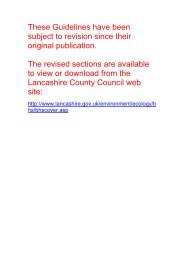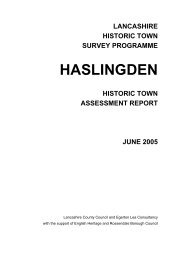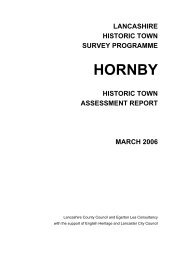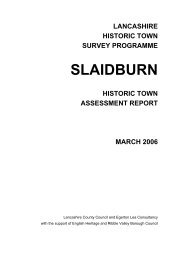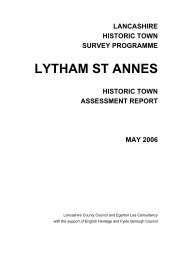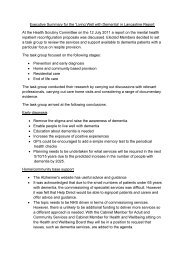<strong>Lancashire</strong> Historic Town Survey<strong>Colne</strong>non-conformist chapels. The Baptists opened the first Sunday School, presumably in thechapel, in 1800 (Harrison 1988, 116), and in 1853 a purpose-built Sunday school waserected on the former burial ground at Zion Chapel, with another behind Trinity Chapel in1883 (Yates 1985, 16). This latter school later became the Baptist church. By 1825, theWesleyan Methodists in <strong>Colne</strong> Lane, the Independent Methodists in Commercial Road andthe Congregationalists in Dockray Square all had their own Sunday schools (Baines 1825,619). The Wesleyans also had a dedicated school building by 1848 behind Victoria Mill on<strong>Colne</strong> Lane (OS 1851, 1:1056), presumably in their former chapel. This was replaced withnew Sunday and day schools in 1868 in Great George Street (Harland 1870, 29), whichwas the largest school in <strong>Colne</strong> by 1899 (Harrison 1988, 119). In addition, the Wesleyanshad schools in their chapels at Collingwood Street and Cotton Tree Lane as did thePrimitives at Skipton Road and Bunkers Hill. The Bethel chapel built a new school onBurnley Road in 1872 (Harrison 1988, 109; Pevsner 1969, 106). This building still standsas does the Inghamite school, built in 1877 and which later became a chapel (Pevsner1969, 106). A Local School Board was formed in 1897, when the first Board school wasopened at The Park on Gordon Street, followed by Lord Street School in 1902 (Harrison1988, 120). Adult education began in 1862, when Railway Street Iron School was foundedby Mr and Mrs Wildman and supported by voluntary subscription (Harland 1870, 29). Atechnical school was opened in 1902, which became a secondary school following thepassing of the Education Act of 1902 (Harrison 1988, 63, 120).Public Buildings<strong>Colne</strong>’s position as an early commercial centre for the woollen cloth trade resulted in thedevelopment of the Piece, or Cloth, Hall, in 1775. It was evidently built to be impressive, asit was twenty-three bays long and had a five baypediment (Pevsner 1969, 106-7). The fifteenth centurymarket cross indicates the presence of a market from atleast the end of the medieval period(www.imagesofengland.org.uk), although no market hallwas provided until the beginning of the twentieth-century,when a market hall was opened on Dockray Street (OS1912 1:2500). A Mechanics’ Institute was established in1847 at Cumberland House on Market Street, a formermill owner’s house, and which continued until 1870, laterbecoming the Union Hotel (Spencer 1972, 16). <strong>Colne</strong>acquiredmore publicbuildingsPlate 9: <strong>Colne</strong> fire stationfollowing theestablishmentof the Local Board in 1875 (Farrer and Brownbill1911, 530). By 1870, there was a court houseused by both petty sessions and the countycourt, (Harland 1870, 29), and a fire station wasestablished in converted cottages in DockrayStreet in 1886. This was replaced by a newbuilding on the same site in 1905 (Harrison1988, 58, 63). A Free Trade Hall had openedon the north side of the town centre, on Ivegate,by 1891 (OS 1893 1:2500), although this hadbecome the Theatre Royal by 1911 (Farrer andBrownbill 1911, 530). The Town Hall, designedby JW and RF Beaumont in ‘symmetrical mildly Plate 10: The Town Hall of 1894domestic gothic’ style opened in 1894, followedby the Municipal Hall, by Woodhouse and Willoughby in Elizabethan style, in 1901-2© <strong>Lancashire</strong> <strong>County</strong> <strong>Council</strong> 2005 25
<strong>Lancashire</strong> Historic Town Survey<strong>Colne</strong>(Pevsner 1969, 106-7). A library was opened in 1895 but it was not until 1907 that, withfunding from the Carnegie Foundation, it obtained its own premises at The Gables, anotherformer mill owner’s house in Albert Road, (Harrison 1988, 63, 124). In the early 1900s, theCorporation developed the only remaining area of open ground in the town centre, betweenMarket Street and West Street and to the east of <strong>Colne</strong> Lane, where there had been afootball ground in the early 1890s (OS 1893 1:2500). The area was laid out as a crescent,called Ludgate Circus, centred on a new cattle market, with a new public baths on the westside, and with, in 1906, a new <strong>Council</strong> school to the south (Harrison 1988, 120).Public Utilities<strong>Colne</strong>’s status as an early centre of the woollen cloth industry led to the early establishmentof a water supply. In 1806 a waterworks company was established to provide <strong>Colne</strong> withwater piped from Flass Spring near Laneshaw Bridge about two miles east of the town(Harland 1870, 29). The main customers were businesses, however, and many inhabitantshad to rely on local springs. Although a small reservoir was subsequently built at Bents,which was rebuilt in 1867, complaints about the poor quality of the water continued(Harrison 1988, 52), and the town was hit by an epidemic of typhoid early in 1876. TheLocal Board acquired the water company in 1880, although a new reservoir at LaneshawBridge, begun in 1884 was not completed until 1889 (Harrison 1988, 61-2). A sewageworks was built at Greenfield in 1885, although the system was not finally completed until1888 (Harrison 1988, 61). In 1838, the <strong>Colne</strong> Gaslight and Coke Company established agasworks in Gas Street (Wightman nd), and the first street lamps were erected in 1840,and by 1842 a new works was built on land in Green Lane (Harrison 1988, 61). In 1877 theCompany was taken over by the Local Board (Farrer and Brownbill 1911, 530) and theworks at Green Road were extended further in 1891 and 1894 (Harrison 1988, 61).Attempts were made to improve the streets from as early as 1823, by the construction ofcauseways, which were patrolled by nightwatchmen until 1840 and a paid constable wasappointed in 1834 (Harrison 1988, 51). In 1859, land was purchased for a cemetery,opened in 1960, which had ‘two handsome chapels with elegant spires linked by a gatewaywith a tower over’ (Pevsner 1969,106) designed by Pritchett of Darlington (Harland 1870,29). In 1901 the supply of electricity began from the works on Phillips Lane (Wightman nd,1).© <strong>Lancashire</strong> <strong>County</strong> <strong>Council</strong> 2005 26



